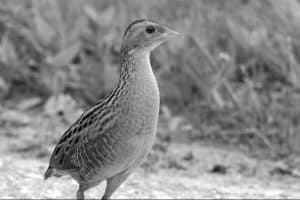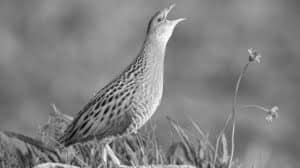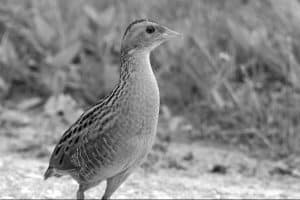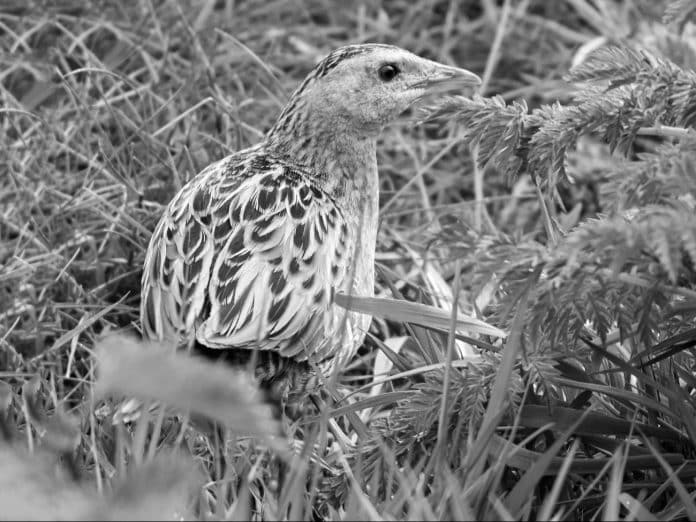Introduction to the Corn Crake in Tanzania
The Corn Crake (Crex crex) is a fascinating grassland bird that can be found in the beautiful country of Tanzania, located in Eastern Africa. This medium-sized bird is known for its elusive nature and unique characteristics. In this article, we will explore the habitat, behavior, conservation status, and research efforts surrounding the Corn Crake in Tanzania. We will also provide tips for birdwatchers and photographers who are eager to spot this elusive bird in its natural habitat. So, let’s dive into the world of the Corn Crake and discover the wonders it holds.
Habitat and Distribution of the Corn Crake

The Corn Crake is primarily found in grasslands and meadows, making Tanzania an ideal home for this species due to its vast expanses of grassy plains. These birds prefer areas with dense vegetation, such as tall grasses and reeds, as they provide excellent cover for nesting and foraging. In Tanzania, the Corn Crake can be spotted in various regions, including the Serengeti National Park, Ngorongoro Conservation Area, and Selous Game Reserve.
Although the Corn Crake is known to have a wide distribution across Europe and Asia, its presence in Tanzania is particularly special. The country’s diverse grassland ecosystems offer the perfect conditions for this bird to thrive. However, due to habitat loss and degradation, the Corn Crake’s population has been declining in many parts of its range. This makes Tanzania’s grasslands even more critical for the survival of this elusive bird.
Behavior and Characteristics of the Corn Crake
The Corn Crake is a secretive bird that is more often heard than seen. It is known for its distinctive call, a repetitive and raspy sound that resembles the phrase “crex-crex.” This vocalization is usually heard during the breeding season, as the male Corn Crake uses it to attract a mate and establish its territory. Despite its loud call, the Corn Crake is a master of camouflage and can easily blend into its surroundings, making it challenging to spot.
These birds are primarily active during the night and at dawn, spending their days hidden in the dense vegetation of grasslands. They have a diet consisting mainly of insects, worms, and small invertebrates. The Corn Crake is also known for its unique breeding behavior. The female lays a clutch of eggs in a hidden nest on the ground, and both parents take turns incubating the eggs and caring for the young chicks once they hatch.
Conservation Status and Threats to the Corn Crake
The Corn Crake is classified as a “Near Threatened” species on the International Union for Conservation of Nature (IUCN) Red List. The main threats to the Corn Crake population in Tanzania and other parts of its range are habitat loss and degradation due to agricultural expansion, urbanization, and the drainage of wetlands. As grasslands are converted into farmland and human settlements, the Corn Crake’s habitat is shrinking, leaving them with limited areas to breed and forage.
In addition to habitat loss, the use of pesticides and herbicides in agricultural practices poses a significant threat to the Corn Crake. These chemicals can contaminate the bird’s food sources and have adverse effects on their health and reproductive success. Climate change is also a concern, as it can alter the timing of the Corn Crake’s breeding and migration patterns, affecting their ability to find suitable habitats and resources.
Research and Monitoring Efforts for the Corn Crake in Tanzania

To better understand the population dynamics and ecological needs of the Corn Crake in Tanzania, researchers and conservation organizations are conducting various studies and monitoring programs. These efforts help gather valuable data on the bird’s distribution, abundance, and habitat requirements. By tracking the movements and behaviors of individual Corn Crakes, scientists can identify key areas for conservation and make informed management decisions.
One such initiative is the collaboration between local and international organizations to establish long-term monitoring sites and conduct regular surveys in Tanzania’s grasslands. These surveys involve recording the bird’s vocalizations, conducting habitat assessments, and using specialized techniques such as radio telemetry to track their movements. These research efforts provide essential insights into the Corn Crake’s population trends and the effectiveness of conservation measures.
Best Places to Spot the Corn Crake in Tanzania
If you’re an avid birdwatcher or photographer, Tanzania offers some excellent opportunities to spot the elusive Corn Crake. The Serengeti National Park, with its vast grassy plains and diverse wildlife, is a popular destination for bird enthusiasts. The Ngorongoro Conservation Area, known for its stunning landscapes and rich biodiversity, is another great place to search for this elusive bird. Additionally, the Selous Game Reserve, with its vast wetlands and mosaic of habitats, provides a unique chance to encounter the Corn Crake in its natural environment.
To increase your chances of spotting a Corn Crake, it’s best to visit these areas during the breeding season, which typically occurs between May and July. Early mornings and late evenings are the most active times for these birds, so plan your birdwatching expeditions accordingly. Keep in mind that the Corn Crake is a master of hiding, so patience and a keen ear are essential when searching for them in the grasslands of Tanzania.
Tips for Birdwatching and Photographing the Corn Crake
If you’re planning to embark on a birdwatching or photography adventure to capture the beauty of the Corn Crake, there are a few tips to keep in mind. Firstly, make sure to equip yourself with a pair of binoculars or a telephoto lens to observe the bird from a distance without disturbing its natural behavior. It’s crucial to respect their space and avoid getting too close, as this can cause stress and disrupt their activities.
When photographing the Corn Crake, try to capture its unique characteristics and behavior in a natural and unobtrusive manner. Patience is key, as these birds may take some time to reveal themselves. Be prepared to spend long hours observing their habitat and listening for their distinctive call. Remember to respect the environment and adhere to ethical photography practices, ensuring that your presence does not harm the bird or its habitat.
The Importance of Protecting Grassland Habitats in Tanzania

The conservation of grassland habitats in Tanzania goes beyond the preservation of the Corn Crake and other bird species. These grasslands are vital ecosystems that support a wide range of flora and fauna, including large herbivores like wildebeest and zebra. They also provide essential ecosystem services, such as carbon sequestration, water filtration, and soil stabilization.
Protecting grasslands in Tanzania requires a multi-faceted approach, including the establishment of protected areas, sustainable land management practices, and community engagement. Collaborative efforts between government agencies, conservation organizations, local communities, and tourism stakeholders are crucial for the long-term conservation of these unique habitats. By safeguarding grasslands, we can ensure the survival of the Corn Crake and other species that depend on these fragile ecosystems.
Other Interesting Birds of Tanzania’s Grasslands
While the Corn Crake undoubtedly holds a special place in Tanzania’s grasslands, it is not the only bird species worth exploring in this diverse region. The grasslands of Tanzania are home to an array of avian wonders, including the Secretarybird, Kori Bustard, and the endemic Grey-breasted Spurfowl. These birds showcase the incredible diversity and beauty of Eastern Africa’s grassland ecosystems.
The Secretarybird (Sagittarius serpentarius) is a large, striking bird characterized by its unique crest of feathers and long legs. It is known for its impressive hunting skills, as it stomps on its prey with powerful kicks. The Kori Bustard (Ardeotis kori) is one of the heaviest flying birds in the world, with males weighing up to 19 kilograms. This magnificent bird is known for its elaborate courtship displays, which involve puffing up its feathers and inflating its throat sac.
The Grey-breasted Spurfowl (Pternistis rufopictus) is an endemic species found exclusively in Tanzania’s grasslands. With its intricate plumage and distinctive call, this bird is a true symbol of the country’s avian diversity. These are just a few examples of the many fascinating birds that can be encountered in Tanzania’s grasslands, making it a paradise for birdwatchers and nature enthusiasts.
Conclusion: Celebrating the Beauty and Importance of the Corn Crake in Tanzania
The Corn Crake is undoubtedly one of Tanzania’s hidden gems, a bird that captivates with its unique characteristics and elusive nature. As we delve into the world of the Corn Crake, we gain a deeper appreciation for the importance of preserving grassland habitats in Tanzania. By protecting these ecosystems, we not only safeguard the future of the Corn Crake but also ensure the survival of numerous other bird species and the overall health of the environment.
So, the next time you find yourself in Tanzania’s grasslands, take a moment to listen for the raspy call of the Corn Crake and appreciate the wonders it represents. Let us celebrate the beauty and significance of this elusive grassland bird, and join hands in protecting its habitat for generations to come.


































